DmC: Devil May Cry Preview: A Rebel Yell
Ninja Theory's reinvention of Dante tears things up.
"Dante's not gay, but I wish he was" says Ninja Theory creative director Tameem Antoniades. "That would teach all those homophobes out there."
I wish he was gay, too. Aside from being a bigot repellent, it would have been more fitting for Ninja Theory's reimagining of the Devil May Cry series. "The theme of the story is about rebellion," Antoniades states. Everything ties into that notion from Dante's brash attitude, to the street art aesthetic, drastic character redesigns, the name of his sword, and the peculiar abbreviation that keeps that 'm' lowercase for no particular reason.
This sticking-it-to-the-man attitude is apparent from the start of Ninja Theory's presentation, wherein Dante knocks out a bouncer in order to infiltrate a nightclub run by a demon named Lilith. In the world of DmC, demons manipulate aspects of society, and she uses this club to convert members of the upper classes into demon collaborators. "Lilith is like the queen of entertainment," Antoniades notes. "She's like the Simon Cowell of limbo."
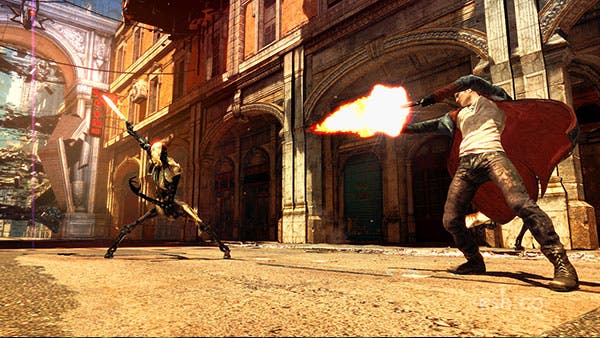
Lilith greets our heartthrob demon hunter by lowering the portion of the floor he's on, while the rest of the club expands vertically to reveal several layers of balconies like a pop up book. No one seems to mind, though, as Dante is in an alternate dimension. He's on an ever-changing dance floor surrounded by neon tiled walls with silhouettes of the club's dancing crowds in the real world reflected in their surface.
Throughout the fight the set continually reconstitutes itself. Sometimes it has a stage full of spinning red spotlights, other times the walls break away to multicoloured electric geometric shapes that look like something out of Rez, while at other times the walls throb in conjunction with the pulsating soundtrack.
At one point Dante's fighting off creatures that look like a mix between a porcupine and a hyena, while a strobe light flickers about. The sheer visual inventiveness to come out of these morphing set-pieces is phenomenal. If games can continue to look this good, I'm in no rush for the next-gen.
This trippy, more psychedelic iteration is a far cry from the series' usually grim, gothic architecture. "We wanted to give the game a more contemporary setting," says Antoniades. Besides simply looking astonishing, the colourful setting has gameplay ramifications as well. During some portions of the battle certain floor tiles glow blue or red, requiring you to switch between devil or angel powers to stand on them without getting hurt.
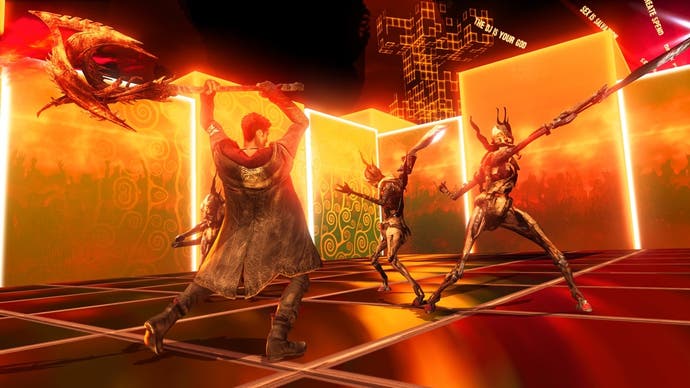
Here's how it works: Dante has three fighting modes. By default he operates similarly to the Dante of yesteryear with face buttons allowing him to shoot, swing his sword, and use special attacks. Hold the right trigger however, and Dante goes into 'devil mode' where instead of a sword he swings a mammoth glowing red axe that's slow, but packs a hefty wallop, and instead of shooting he tosses a grappling hook that yanks enemies towards him. Hold the left trigger, and he'll enter 'angel mode' where his melee weapon becomes a scythe that starts out weak, but gets increasingly powerful the longer he goes without taking damage. In this mode the grappling hook is used to pull Dante towards foes and ledges rather than the other way around.
There's a fourth mode, too, that should be familiar to Devil May Cry veterans: the devil trigger. Fill up a meter high enough and you can go into a berserk mode where your hair turns white and your coat red, while you move faster, inflict extra damage and regain heath. Since devil trigger is only a temporary power-up, it seems less integral to the moment to moment combat, whereas switching between three move/weapon sets drastically changes how you play. Besides the aforementioned floor tiles, certain enemies are immune to various attacks. Frozen foes require angel powers to defeat, while fiery ones are vulnerable to demon-based attacks.
Elsewhere, DmC will have an adaptive difficulty based on your performance, a feature seen before in God Hand. Achieve an SS rank and enemies will be quicker and more aggressive. Perform poorly and they'll put up less of a fight.
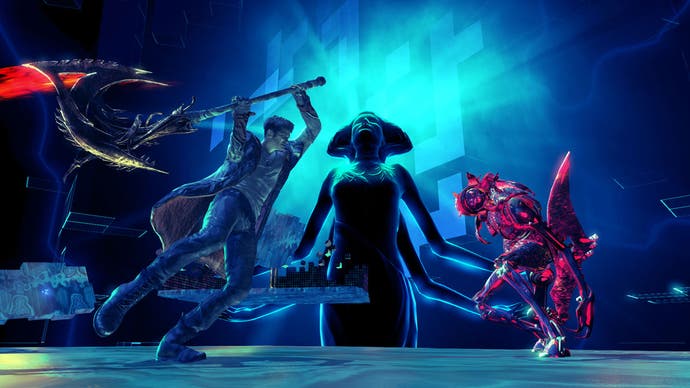
It can take a while to get used to if your muscle memory is as ingrained as mine is. There's no targeting system this time around, so you're at the mercy of the automatic lock-on. For the most part this works, and it instinctively targets who you want. The only thing that bothered me was that the sword-dash move is now done by double tapping the left analogue stick forward then pressing a button, which feels less intuitive than in the old games where you'd target an enemy then press forward and the melee attack button. This is a very minor gripe though, and something we'll likely adapt to in time.
What Ninja Theory hasn't changed is the series' penchant for enormous, challenging and grotesque boss battles. In a later demo Dante finds himself in what appears to be the ruins of an underground temple comprised of a series of platforms with a sea of lava running underneath. Suspended over the lava is a colossal many legged maggot-like creature whose head looks a bit like a diseased pink version of Psychonaut's Bobby Zilch - only instead of a giant afro, she's got what looks like a sac of blood behind her head that nearly envelopes her face. It's truly disgusting in the best possible way.
After a brief humourous exchange that ends with both characters yelling, "f**k you" back and forth, she vomits acid all over the platform. While she mostly attacks with her limbs, she occasionally covers the ground in demon puke, so you have to grapple to a new platform. She can be toppled by gingerly chipping away at her health and rolling away from her swipes, or you can parry her sweeping attack, leaving her stunned so you can grapple her noggin for extra damage. Upon her demise Dante rips off the wires suspending her from the lava until she gets shredded in a fan below. Thankfully, her gruesome death doesn't involve a single QTE. "We wanted to avoid quick-time sequences," says Antoniades. "That's not DMC."

While this all seems ridiculous Antoniades insists that this new version of Devil May Cry is a more sincere approach to the series. "It's more grounded in some ways," he says. "You could say it's more serious." The individual elements are still ludicrous, but it deals with more real world themes like media and government control.
Antoniades explains that, "the satire is a rebellion of establishment. It harkens back to a post-punk period." 28 Days Later and Enslaved scribe Alex Garland is on board as a story consultant, so the narrative aspects that made the previous titles embarrassing to play around polite society should see a vast improvement. "Story is very important to us," adds Antoniades, who explains that they're using Giant Studios, the motion capture company behind Avatar, to help bring this tale to life.
More Baz Luhrmann than Michael Bay, Ninja Theory's new take on Devil May Cry is loud, vibrant, and bombastic. DmC may be the fifth game in its series, but rather than appear stale, it's among the most exciting, hyper-kinetic, visually arresting games I had the pleasure to check out at E3. Dante may not be the first gay action game hero, but that doesn't mean he can't still shake things up.


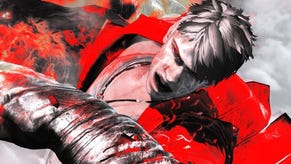
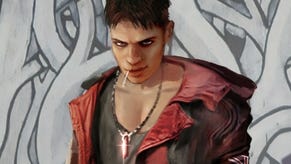



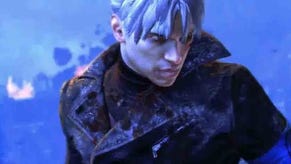
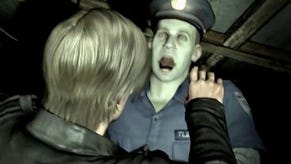



.png?width=291&height=164&fit=crop&quality=80&format=jpg&auto=webp)



